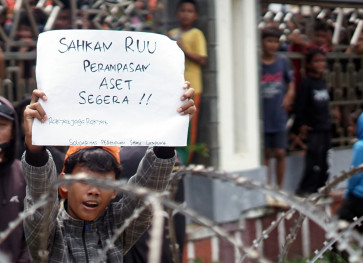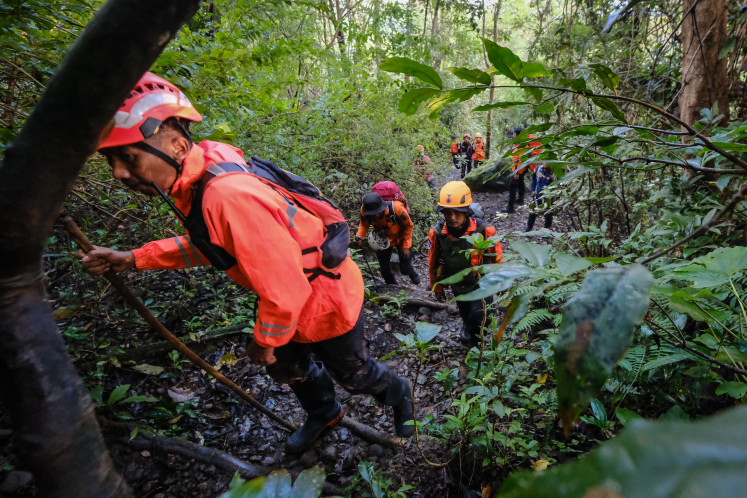Popular Reads
Top Results
Can't find what you're looking for?
View all search resultsPopular Reads
Top Results
Can't find what you're looking for?
View all search resultsThe 2011 Science Film Festival: Sparking inquisitive minds
Here’s a science pop quiz
Change text size
Gift Premium Articles
to Anyone
H
ere’s a science pop quiz. Are hydrogen-fueled cars the answer to cleaner air? Is honey really an elixir of life or simply saccharine bee vomit?
Bursting: Mount Merapi erupts violently on Nov. 14, 2010. The only entry from Indonesia for the 2011 Science Film Festival was a short, I Got It: The Volcano Episode, about the mountain. JP/J. Adiguna
Can you answer these science questions? Moreover, can you get children to buzz about such scientific ruminations over movies and popcorn?
Positively yes, experts hypothesize.
“Science movies are crafted to make learning about science more fun and enjoyable,” the CEO of Sustainable Forest Conservation, Agus P. Sari, said.
“That is why many science movies are geared to children,” he added, in reference to the films at the Science Film Festival.
The Science Film Festival is a roadshow of 16 science-themed documentaries geared to children and youth. This year, the Goethe Institute, as the organizers of the event, has settled on 20 venues across 12 cities stretching from Jakarta to Gowa and Jayapura in which to screen the free movies.
Agus added that the movies highlighted not only matters of the environment, but also spoke of poverty and justice in a softer light.
“There were not many special cinematographic techniques used but the method of storytelling was adapted to children,” he said.
The movies were indeed geared to a more boisterous audience. One of the documentaries, a nearly 10-minute German film called Nine and a Half: Bees in Danger featured high school students speaking on the importance of bees and a comical woman dressed in a bee costume, complete with a detachable stinger.
Honeymakers: One of the documentaries screened at the fi lm festival was Nine and a Half: Bees in Danger, featuring high school students speaking on the importance of bees. JP/P.J. Leo
Another film, Mouse TV: Fuel Cell, featured a grandfatherly scientist giving facile explanations of how fuel-cell automobiles work with the help of toy cars, spherical balls and plenty of smiles.
The film even gave instructions on how children can experiment with hydrogen power with nothing but batteries, salt water and a test tube.
Agus added that the film selection process also involved two children who joined the panel of judges responsible for picking the 16 movies to be played at the festival out of the 50 films contributed by moviemakers worldwide.
However, he noted that only one entry, I Got It: The Volcano Episode, came from Indonesia. For the majority, narration or subtitles in Bahasa Indonesia were added, as most of the films were made in European countries, with only a handful from Southeast Asia.
“I think it’s because [Indonesian] filmmakers are still thinking more about commercial films than science films, which are mostly documentaries. [Filmmakers] must receive funding through non-commercial means and there is not much funding in Indonesia for those movies,” he said.
The Indonesian documentary on Mount Merapi was co-produced by state-owned television TVRI and the Goethe Institute.
Katrin Sohns, Goethe Institute regional coordinator for culture and development in Southeast Asia, said the dearth of contributions from filmmakers in Southeast Asia was
“a really big issue” in holding the festival.
The Goethe Institute usually does a call for entries a year before the launch of the annual festival, which is also held in countries such as the Philippines and Thailand.
She added that the organizers counted on the festival, as well as the Southeast Asian Student Documentary Award (SEADocs), to encourage future participation from Southeast Asian filmmakers.
“This way, we try to encourage the young to actually make films on these [environmental] topics themselves because it is not about just importing films from all over the world, but it is also triggering interest from all these countries,” she told The Jakarta Post.
As for the children and youth, Katrin hoped that the movies would peel away the boring label science was stuck with.
“I think that association to something uncool is something that can still be changed,” she said. “I think this region needs good scientists so it has the answers for the questions it is facing.”
Paramadina University rector Anies Baswedan added that the movies were a creative way to fan interest in science.
“Movies are an effective means in appealing to children’s interest in science and the theme of this year’s festival,” he said.
Vital: Visitors are able to walk through mangrove forest, which are vitally important to tropical coastlines, along a pathway in Bali. One of the aims of the Science Film Festival is to foster children’s interest in science, which includes understanding of environmental issues with this year’s theme “Tree(s) of Life: Seed of Change”. JP/Agung Parameswara
This year, the festival focuses on forest conservation by adopting the theme, “Tree(s) of Life: Seeds of Change”.
“This year, the environment has not yet received significant attention in primary education. However, this trend is changing quickly. [We] are starting to view the environment from a different perspective,” he added.
He pointed out that the effort in building up interest in science should not cease with the festival, but should be kept up by teachers and parents alike.
“School and homes must continue enticing children who have been stimulated by the movies,” he said.
According to Anies, teachers and parents can set up simple experiments, sometimes requiring only batteries, to mimic those seen in the films.
“Schools with their systematic programs can ready children to go outside and explore the environment to stimulate the children’s senses. That activity alone would have already instilled a new awareness [of the environment],” he said.
He added that the limited number of venues where the movies were screened did not decrease the significance of the festival.
“Hundreds of Indonesian children will be present at each screening so I think that the effect could be considerable. And don’t forget that those exposed to the movies are children, so the effect on them would be long term,” he said.
Katrin pointed out that the Goethe Institute was open to more schools, universities and museums in partnering up with them to screen the movies.
“We have already started preparations for next year. The open call for filmmakers also starts in January, so filmmakers can start sending their films any time,” she pointed out.












